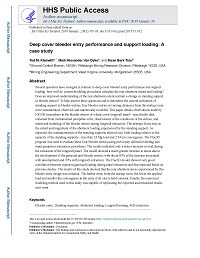Mining Publication: Deep Cover Bleeder Entry Performance and Support Loading: A Case Study
Original creation date: January 2018
Authors: T Klemetti, M Van Dyke, I Tulu
Several questions have emerged in relation to deep cover bleeder entry performance and support loading: how well do current modeling procedures calculate the rear abutment extent and loading? Does an improved understanding of the rear abutment extent warrant a change in standing support in bleeder entries? To help answer these questions and to determine the current utilization of standing support in bleeder entries, four bleeder entries at varying distances from the startup room were instrumented, observed, and numerically modeled. This paper details observations made by NIOSH researchers in the bleeder entries of a deep cover longwall panel—specifically data collected from instrumented pumpable cribs, observations of the conditions of the entries, and numerical modeling of the bleeder entries during longwall extraction. The primary focus was on the extent and magnitude of the abutment loading experienced by the standing support. As expected, the instrumentation of the standing supports showed very little loading relative to the capacity of the standing supports—less than 23 Mg load and 2.54 cm convergence. The Flac3D program was used to evaluate these four bleeder entries using previously defined modeling and input parameter estimation procedures. The results indicated only a minor increase in load during the extraction of the longwall panel. The model showed a much greater increase in stress due to the development of the gateroad and bleeder entries, with about 80% of the increase associated with development and 20% with longwall extraction. The Flac3D model showed very good correlation between expected gateroad loading during panel extraction and that expected based on previous studies. The results of this study showed that the rear abutment stress experienced by this bleeder entry design was minimal. The farther away from the startup room, the lower the applied load and smaller the convergence in the entry if all else is held constant. Finally, the numerical modeling method used in this study was capable of replicating the expected and measured results near seam.

- Coal Bumps and Odd Dynamic Phenomena - A Numerical Investigation
- Development of Guidelines for the Design of Support Systems to Manage Coal Mine Rib Hazards
- Evaluation of the Impact of Standing Support on Ground Behavior in Longwall Tailgates
- A First Step in Developing Roof Support Design Criteria Based on Ground Reaction Data for Pittsburgh Seam Longwall Tailgate Support
- Investigation of Pillar-Roof Contact Failure in Northern Appalachian Stone Mine Workings
- Loading Characteristics of Mechanical Rib Bolts Determined Through Testing and Numerical Modeling
- MIS Analysis and DINSAR Measurements � Tools for Improving Mine Ground Control Safety
- Mitigation of Groundfall Hazards Through Integration of Novel Field and Numerical Techniques
- Numerical Modeling for Increased Understanding of the Behavior and Performance of Coal Mine Stoppings
- Support Design Procedures for Difficult Ground Conditions